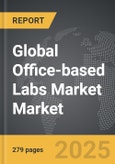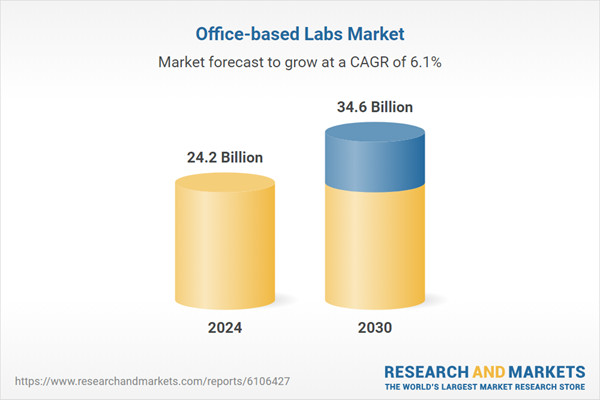Global Office-Based Labs Market - Key Trends & Drivers Summarized
Why Are Office-Based Labs Emerging as a Preferred Healthcare Delivery Setting?
Office-based labs (OBLs) are increasingly seen as an effective alternative to hospital-based care for a variety of minimally invasive diagnostic and therapeutic procedures. These facilities, often operated by specialists such as interventional cardiologists, vascular surgeons, and radiologists, allow treatments to be performed within the physician's own practice. This model not only improves scheduling flexibility but also reduces reliance on hospital infrastructure, enhancing both cost-efficiency and patient convenience.For many physicians, the OBL model offers better control over clinical workflows and patient relationships. Procedures that were once limited to hospitals, such as angioplasties, stent placements, and venous ablations, can now be safely performed in outpatient settings without compromising quality or safety. Patients benefit from shorter wait times, reduced exposure to hospital-acquired infections, and personalized care within a familiar environment. As demand grows for decentralized healthcare services, OBLs are helping bridge accessibility gaps while maintaining a high standard of care.
How Are Technological and Operational Innovations Supporting the Growth of OBLs?
Innovations in medical technology are significantly expanding the scope of procedures that can be performed in OBLs. Advances in portable imaging, catheter-based devices, and laser systems have enabled precise interventions in smaller, non-hospital settings. These technologies require less infrastructure, which lowers setup costs and simplifies compliance with outpatient safety standards. Integrated diagnostic platforms, digital workflow tools, and remote technical support further enhance operational efficiency and clinical performance.Operational models have also matured, making OBLs easier to establish and scale. Many providers now partner with turnkey service vendors for lab construction, equipment procurement, and staff training. Additionally, customized reimbursement support, regulatory consulting, and supply chain coordination are helping physicians navigate the transition from hospital-based practice to independent outpatient care. This ecosystem of support is removing many of the traditional barriers to entry, enabling broader adoption of the OBL model across specialties and geographies.
What Market and Policy Trends Are Expanding the Reach of Office-Based Labs?
Healthcare systems are actively promoting cost-effective care delivery, and OBLs align with this goal by offering high-quality services at lower operational costs. Reimbursement reforms in several regions now support site-of-service neutrality, allowing procedures performed in OBLs to receive similar compensation as those conducted in hospitals. This creates a compelling incentive for providers to shift suitable procedures to outpatient labs, where overheads are lower and scheduling is more streamlined.Patient preferences are also influencing this shift. Many individuals now seek convenient care experiences with shorter recovery times and minimal disruption to daily routines. OBLs meet this need by offering same-day procedures in a setting that avoids the complexity and impersonality of hospital systems. Growth in preventive care, rising chronic disease incidence, and expansion into underserved areas are further driving adoption. As awareness and trust in the OBL model increase, these labs are becoming a standard part of specialty practice growth strategies.
Growth in the office-based labs market is driven by several factors.
The shift toward value-based care is prompting physicians to seek models that combine clinical autonomy with cost-effectiveness, and OBLs fit this need by enabling outpatient procedures without compromising safety. Technological innovations, particularly in compact interventional tools and imaging systems, are broadening the procedural scope that can be safely delivered in office-based settings. Evolving reimbursement policies that favor lower-cost care environments are reinforcing the financial viability of OBLs for both payers and providers. Additionally, the rising demand for patient-centered care, shorter recovery timelines, and reduced hospital dependency is increasing preference for outpatient solutions. As support systems for lab setup, compliance, and staffing continue to improve, office-based labs are expected to become a core component of specialty care delivery in both urban and regional markets.Report Scope
The report analyzes the Office-based Labs market, presented in terms of market value (US$). The analysis covers the key segments and geographic regions outlined below:- Segments: Set-Up Model (Single Specialty Set-Up Model, Multi-Specialty Set-Up Model, Hybrid Set-Up Model); Service (Peripheral Vascular Intervention, Interventional Radiology, Endovascular Therapy, Cardiovascular, Other Services).
- Geographic Regions/Countries: World; United States; Canada; Japan; China; Europe (France; Germany; Italy; United Kingdom; Spain; Russia; and Rest of Europe); Asia-Pacific (Australia; India; South Korea; and Rest of Asia-Pacific); Latin America (Argentina; Brazil; Mexico; and Rest of Latin America); Middle East (Iran; Israel; Saudi Arabia; United Arab Emirates; and Rest of Middle East); and Africa.
Key Insights:
- Market Growth: Understand the significant growth trajectory of the Single Specialty Set-Up Model segment, which is expected to reach US$19.4 Billion by 2030 with a CAGR of a 4.9%. The Multi-Specialty Set-Up Model segment is also set to grow at 8.2% CAGR over the analysis period.
- Regional Analysis: Gain insights into the U.S. market, valued at $6.6 Billion in 2024, and China, forecasted to grow at an impressive 9.4% CAGR to reach $7 Billion by 2030. Discover growth trends in other key regions, including Japan, Canada, Germany, and the Asia-Pacific.
Why You Should Buy This Report:
- Detailed Market Analysis: Access a thorough analysis of the Global Office-based Labs Market, covering all major geographic regions and market segments.
- Competitive Insights: Get an overview of the competitive landscape, including the market presence of major players across different geographies.
- Future Trends and Drivers: Understand the key trends and drivers shaping the future of the Global Office-based Labs Market.
- Actionable Insights: Benefit from actionable insights that can help you identify new revenue opportunities and make strategic business decisions.
Key Questions Answered:
- How is the Global Office-based Labs Market expected to evolve by 2030?
- What are the main drivers and restraints affecting the market?
- Which market segments will grow the most over the forecast period?
- How will market shares for different regions and segments change by 2030?
- Who are the leading players in the market, and what are their prospects?
Report Features:
- Comprehensive Market Data: Independent analysis of annual sales and market forecasts in US$ Million from 2024 to 2030.
- In-Depth Regional Analysis: Detailed insights into key markets, including the U.S., China, Japan, Canada, Europe, Asia-Pacific, Latin America, Middle East, and Africa.
- Company Profiles: Coverage of players such as Allsteel, Branch Furniture, Global Furniture Group, Haworth, Herman Miller and more.
- Complimentary Updates: Receive free report updates for one year to keep you informed of the latest market developments.
Some of the 36 companies featured in this Office-based Labs market report include:
- Abbott Laboratories
- ACM Global Laboratories
- ARUP Laboratories
- BioReference Laboratories
- Cleveland Clinic Laboratories
- DaVita Labs
- Envision Healthcare
- Fresenius Medical Care
- GE Healthcare
- HCA Healthcare
- LabCorp (Laboratory Corporation of America)
- Mayo Clinic Laboratories
- Mednax (Mednax Lab Services)
- PPD (Lab Services)
- Philips (Diagnostic & Point-of-Care Solutions)
- Quest Diagnostics
- Siemens Healthineers
- Sonic Healthcare
- Thermo Fisher Scientific
- Trinity Biotech
This edition integrates the latest global trade and economic shifts into comprehensive market analysis. Key updates include:
- Tariff and Trade Impact: Insights into global tariff negotiations across 180+ countries, with analysis of supply chain turbulence, sourcing disruptions, and geographic realignment. Special focus on 2025 as a pivotal year for trade tensions, including updated perspectives on the Trump-era tariffs.
- Adjusted Forecasts and Analytics: Revised global and regional market forecasts through 2030, incorporating tariff effects, economic uncertainty, and structural changes in globalization. Includes historical analysis from 2015 to 2023.
- Strategic Market Dynamics: Evaluation of revised market prospects, regional outlooks, and key economic indicators such as population and urbanization trends.
- Innovation & Technology Trends: Latest developments in product and process innovation, emerging technologies, and key industry drivers shaping the competitive landscape.
- Competitive Intelligence: Updated global market share estimates for 2025, competitive positioning of major players (Strong/Active/Niche/Trivial), and refined focus on leading global brands and core players.
- Expert Insight & Commentary: Strategic analysis from economists, trade experts, and domain specialists to contextualize market shifts and identify emerging opportunities.
Table of Contents
Companies Mentioned (Partial List)
A selection of companies mentioned in this report includes, but is not limited to:
- Abbott Laboratories
- ACM Global Laboratories
- ARUP Laboratories
- BioReference Laboratories
- Cleveland Clinic Laboratories
- DaVita Labs
- Envision Healthcare
- Fresenius Medical Care
- GE Healthcare
- HCA Healthcare
- LabCorp (Laboratory Corporation of America)
- Mayo Clinic Laboratories
- Mednax (Mednax Lab Services)
- PPD (Lab Services)
- Philips (Diagnostic & Point-of-Care Solutions)
- Quest Diagnostics
- Siemens Healthineers
- Sonic Healthcare
- Thermo Fisher Scientific
- Trinity Biotech
Table Information
| Report Attribute | Details |
|---|---|
| No. of Pages | 279 |
| Published | December 2025 |
| Forecast Period | 2024 - 2030 |
| Estimated Market Value ( USD | $ 24.2 Billion |
| Forecasted Market Value ( USD | $ 34.6 Billion |
| Compound Annual Growth Rate | 6.1% |
| Regions Covered | Global |









